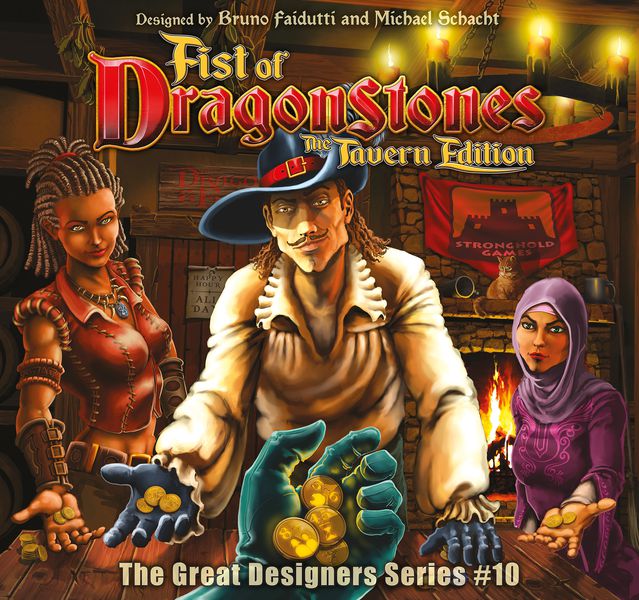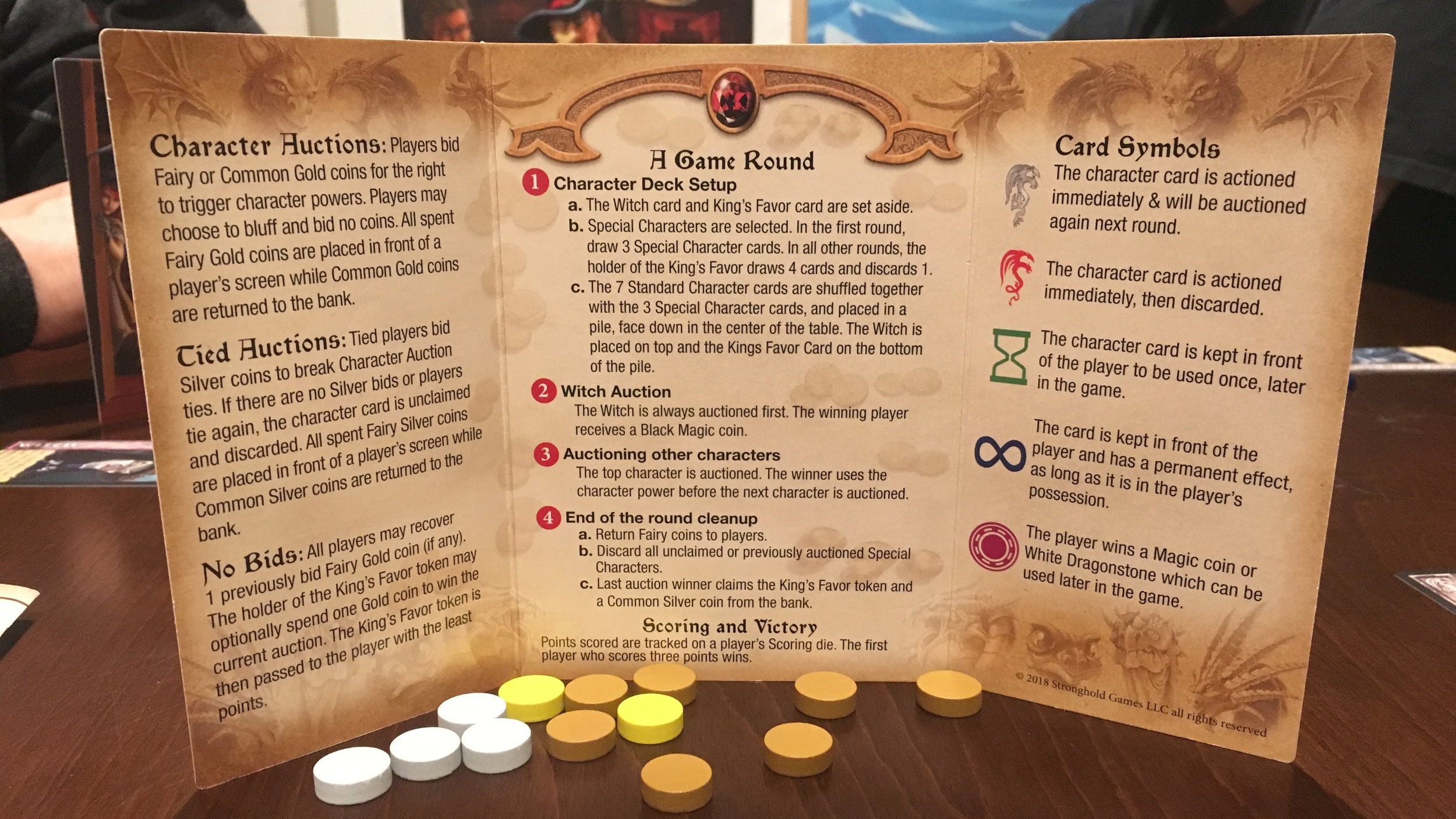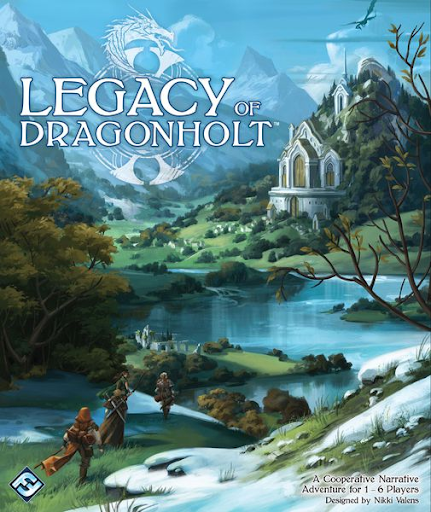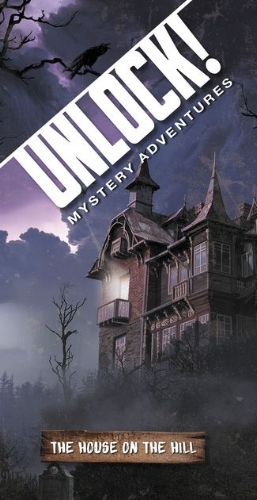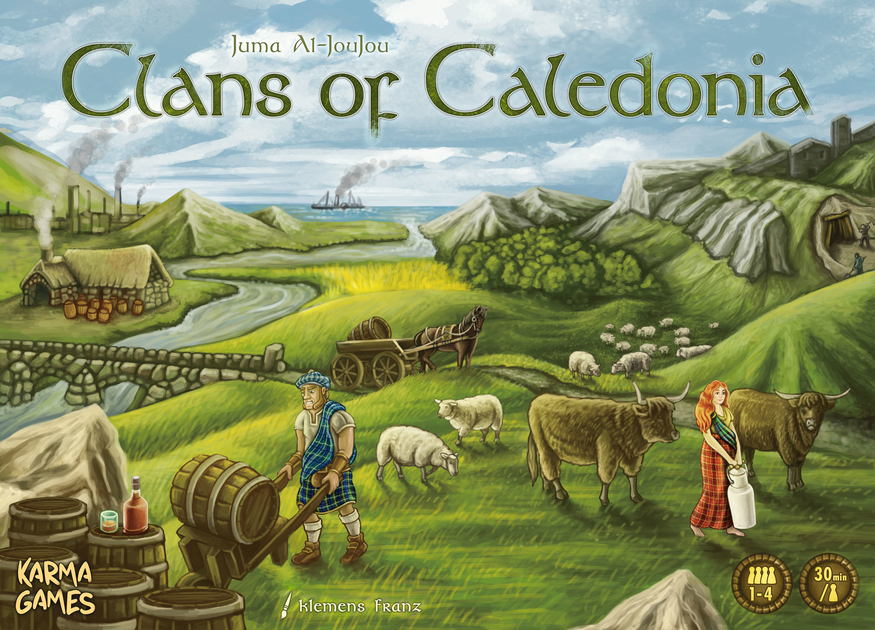Fist of Dragonstones: The Tavern Edition
Designed by Bruno Faidutti & Michael Schacht
Published by Stronghold Games (Tavern Edition 2018)
3-6 Players ~ 45-60 Minutes
Review “Speculative Bewitchment” by Jack Eddy
I love lying in games… even if I’m terrible at it. I can’t help but revel in the sinister pleasure of sewing doubt in the hearts and minds of my friends. You better believe that, even when on the side of the angels, you’ll hear me say “It’s good that you trust me, because I’m certainly a human player OR AM I?” or “Sure, my cart contains 4 chickens. Yes. Chickens. Henrietta, Ezekiel, Trista, and Marge, absolutely and without a doubt NO CROSSBOWS.”
Basically, my only self defense in bluffing games is to lean into how bad of a liar I am, so everything sounds like lies, and seldom are the opportunities for giggly, anxiety-filled bravado so plentiful as when playing Fist of Dragonstones.
Flourish & Bravado (Gameplay)
Dragonstones is a closed fist auction game, where every round, players bid on a sequence of cards one at a time. Want to win an auction? Bid your gold. If there’s a tie amongst bids, boom! A tie-breaker auction is held using silver. All of this is in an effort to rotate your bizarrely dice-like point tracker to it’s 3-pip side, marking you as the victor. Easy.
Well, there’s a little more than that. The cards that you bid on are made up of the Witch (who is always auctioned first), then an assortment of 7 standard characters and three drawn special characters are shuffled together and resolved one at a time. Characters provide a myriad of abilities, but the majority of them boil down to collecting and spending resources, including the three different dragonstones, which are most often spent in one way or another to acquire points. While these basic types of powers are functional and serve as the mechanical backbone of the game, they are also like tax forms; necessary but boring.
No, Dragonstones shines when it gets weird, which fortunately starts at the top of each round with the witch. When won at the auction, her card grants the possessor an immeasurably powerful and terrifying black token. This token can be used to bid on any card later in the round to nullify that card’s effects. Since players have to pay any scratch they bid, the fear of bewitchment is a considerable factor for all players.
There are plenty of other weird powers in the deck, too, ranging from permanent effects that let you keep your dragonstone pile secret to being able to discard your card to essentially “restart” an auction. These cards are what breathe life into an otherwise straightforward resource-conversion auction game.
Thus, round after round proceeds, where the same eight standard cards (including the witch) and three newcomer special characters are bid upon until someone collects their third point. There are a few other mechanics, such as the king's favor, which incentivizes the last bid of the round, but the core loop of flip-bid-repeat remains constant.
Betting with a Dragon’s Hoard (Resources)
How often are resources themselves more interesting than what they are used to buy? By far, the most mechanically interesting system in Dragonstones is the various types of resources and how they impact your decisions.
Earlier, I mentioned that auctions are paid for with silver and gold, but I didn’t mention that each can further be divided between common and fairy silver and gold, all of which are kept hidden behind a player’s screen until their inevitable spending.
Fairy gold is your most prominent resource, which is good, because it is both A) magically delicious, and B) a self-replenishing resource that returns to you each round. Common gold and silver also come stock at the start of the game, but lacking fairy-ish properties, they go back to the support once spent. The elusive and impressively cobalt-colored fairy silver likewise returns to you, but is only available through special character cards which may or may not come up in a given game. Apparently, mortals don’t know jack about currency in the world of Dragonstones (which, in this Tavern Edition, happens to also be the world of Dragon & Flagon, also by Stronghold Games).
Due to the divide between returning and losable currency, players are speculating more about inherent values, acceptable losses, and capabilities of your rivals than ever before. In a way, Dragonstones feels as much of a game about investment as it does about auctioning, even if there is no engine to build, an achievement that is actually really cool.
Unfit & Finish (Components)
From a macro perspective, I dig how the game looks on the table. Cards, gems, player screens adornng the table, the color palette, the glass bead dragonstones that would look at home at the bottom of a fishtank, and the hordes of varying color discs biddable at auction (including sparkly and alluring fairy gold and silver colors)... It all evokes exactly what you want, like this is a card game within a magical world, where you and your friends are in a dingy dwarf-run tavern, flipping cards and spilling grog. Upon closer examination, though, the game looks rough around the edges.
Frankly, I’m not a fan of the art style. In a wide, wide world of incredibly illustrated board games, Dragonstones’ artwork ranges from uninspired to downright bad. Fortunately, there is a sense of cohesion to the game, and some of the illustrations (particularly the creatures) are colorful and attention-grabbing. That being said, if you’re already resistant to an overly saturated market of “generic fantasy” games, this artwork will do nothing to change your mind.
Sadly, this C-Grade vibe extends beyond the art. From the somewhat plastic-y drawstring bag, to the wooden blocks used as point trackers, this is not a premium package, which would be fine if not for the box.
Much to the annoyance of shelf organizers everywhere, this game comes in a non-standard box size, slightly wider than your typical square frame. Okay, that’s fine... except the contents of Dragonstones could easily collapse into a much, much smaller box, and there is no attempt of hiding this fact through deluxe custom inserts, functional compartments, or even some cosmetic fluff. As you crack open the game and peer past the ludicrously oversized rulebook, you gaze upon a sea of white cardboard, with all the components cradled snuggly in a narrow gap at its center.
I am not a publisher, and I don’t know all the considerations manufacturing must take, but the fact that this game was not consolidated to a box a third of its size seems both deceptive and wasteful. At a retail price of nearly $50, Fist of Dragonstones does not feel like a good bang for your buck.
May Your Cup Overflow (Final Thoughts)
Overall, Dragonstones was a fairly enjoyable experience. It feels dated, to be sure, but the game was originally published over 15 years ago. This new edition offers a bevy of new characters that spruce up the game and breathe some new life into the game and provide some much needed variety. And because every turn, every player is bidding, the game seems like the perfect platform for the sort of bluffing shenanigans I love. What can I say, I have an attraction to the auction-by-auction interactions spurred by the evaluation of your opponent’s intended actions.
The thing about Dragonstones, though, is that sometimes, you just flat out don’t care about the current auction, or you’ll have overspent on previous cards, leaving you to just kind of hang back and see what happens. Yes, skilled, confident players will generally do better, but oftentimes the sort of tense risk calculation becomes overwhelming and you throw your hand in and say, “well, whatever happens, happens,” or even worse, everyone knows one player has all they need to secure victory and everyone is just waiting for the inevitable, and nothing kills tension like going through the motions and thinking about what game you are going to play next.
Overall, I feel let down, not because it’s a bad game, but because it seems like a waste. There is no other, closed fist auction game quite like it, but between a sometimes underwhelming conclusion and regrettable production, at $50 it’s a hard recommend.
If you are still interested, “The Tavern Edition” moniker is a good fit. There is a sort of languid charm to the game, a filler meant to be merely a good time-waster with friends, a platform for auctions that are as cunningly sinister as they are hilariously dumb.
A copy of Fist of Dragonstones: Tavern Edition was provided by Stronghold Games
Got questions about the game, the review, or the creative process? Let us know any we may tackle it when we publish our audio version with additional thoughts and Q&A on TCbH Reviews.
The Cardboard Herald is funded by the generous support of readers, listeners, and viewers like you. If you'd like to see more content like this, you can support us on Patreon here.
Other Recent Written Reviews:

